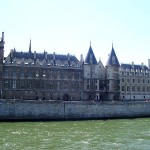
Located on the west side of the Île de la Cité, the Conciergerie Royal palace (the Palais de la Cité) at first and later a prison, the Conciergerie played a dark role in the French Revolution and the Reign of Terror. The remarkable site was chosen by Phillippe le Bel (Philip the Fair) in the early 14th century so that he could build a palace that would be a sign of his wealth and stature.
In his peak of success – the Middle Ages – the palace was considered one of the finest in the world.
The palaces of Louvre and Vincennes were selected by Charles V and the Capetian Kings to be “The conciergierie” by the end of the same century. It was chosen over the Palais de la Cité and later used for the kingdom’s organizational offices. A Concierge is responsible for the maintenance of the palace. He is assigned with legal and police power in the municipality.
The palace had been converted to a prison for both common and political criminals in 1391. Wealthy prisoners were given the best space and accommodations in the former palace while irrelevant thieves were made to sleep in dark, rodent-infested rooms.
There are a few residue of the Conciergerie remains from the Middle Ages. There is the Silver Tower, which apparently the house of the royal treasury. The Caesar Tower, named after the Roman emperors and the Bonbec Tower, which housed a torture chamber.
The Conciergerie became prominent during the French Revolution which took part on 1789-1799. It was the most violent era in French history where convicts were detained at the Conciergerie before taken to the guillotine to be executed. The Revolutionary Tribunal, a court system to test opponents of the French Revolution, was also located in Conciergerie.
The Conciergerie continued to be used for what the French considered the most significant prisoners, such as Napoleon III. Though it’s difficult to tell given its aged appearance, general rebuilding and restoration took place in the mid-19th century, including the renovation of Marie Antoinette’s cell to a chapel. The building was decommissioned for official use in 1914. And later, it was opened to the public as a national historic monument. Today, it remains a popular tourist attraction though access to most of the building is severely limited.

I always considered Paris to be one of those few cities in the world rich with culture and was able to preserve buildings and other artifacts from ancient times. France in general has been through a lot historically, and I find it extremely amazing that up to this date we are still able to witness and actually be inside the buildings that have been here a few years back.
Every time I see pictures of the Conciergerie Royal Palace, I am always left in awe not only because of it’s the architectural design of the building, but more so because of the history that had happened in the same building many years ago. Even though there are some parts which have been renovated, still, the structure remains intact and you still get the ancient feel of the building.
It is also funny how the Conciergerie Royal Palace is now used or part of the judiciary system of Paris when during the ancient times it was home to the great discrimination among men and women and the rich and the poor. Back in the ancient times, how a prisoner was treated greatly depended on his wealth. If you are a prisoner who is part of the upper class, you can be given your own cell complete with a desk for reading and writing and a comfortable bed. The little less fortunate prisoners were made to sleep in rough beds and were lucky enough if they can be given a decent table. There were even prisoners who were confined in dark and isolated cells infested with vermin.
Men and women prisoners were also separated. Fortunately, during that time women were treated a bit more decently than the male prisoners. Females were allowed to make use of areas were they could wash and do a bit of toilet. Also, there cells were left open thus allowing them access to the open courtyard. Still, there were enclosed behind bars thus making it impossible to make contact with the outside world.
Being a great enthusiast of art and ancient or classical architecture myself, I applaud France and most especially Paris for being able to preserve great infrastructures such as these and making it possible for anyone to view it as well.
Conciergerie played a great role in the history of Paris undergone a lot of changes as time passes by. At the same time, its memories, whether good or bad, is put in the dust. Its meaning to the people varies from the past, as different set of people renovated the building and placed a new representation of the building. Many decades ago, Conciergerie building was a prison. At present, it is considered one of the most remarkable piece of art in Paris.
Покупка комплектующих с хранения
ICQ 427-616-956
tel: +38 (063) 407-15-54
Людмила